HI6006: Strategy Development Tools - PESTEL, SWOT, Porter's 5 Forces
VerifiedAdded on 2023/06/12
|8
|1762
|253
Essay
AI Summary
This essay provides a detailed analysis of key strategy development tools, including the SWOT framework for internal environment assessment (strengths, weaknesses, opportunities, threats), the PESTLE framework for external environment analysis (political, economic, social, technological, legal, environmental), and Porter's Five Forces framework for industry competition analysis (competitive rivalry, supplier power, buyer power, threat of substitution, threat of new entrants). The essay uses examples from the retail industry to illustrate the application of each framework, discussing how these tools can be used to inform strategic decision-making and improve business performance. This document is available on Desklib, a platform offering a wide range of study resources for students.
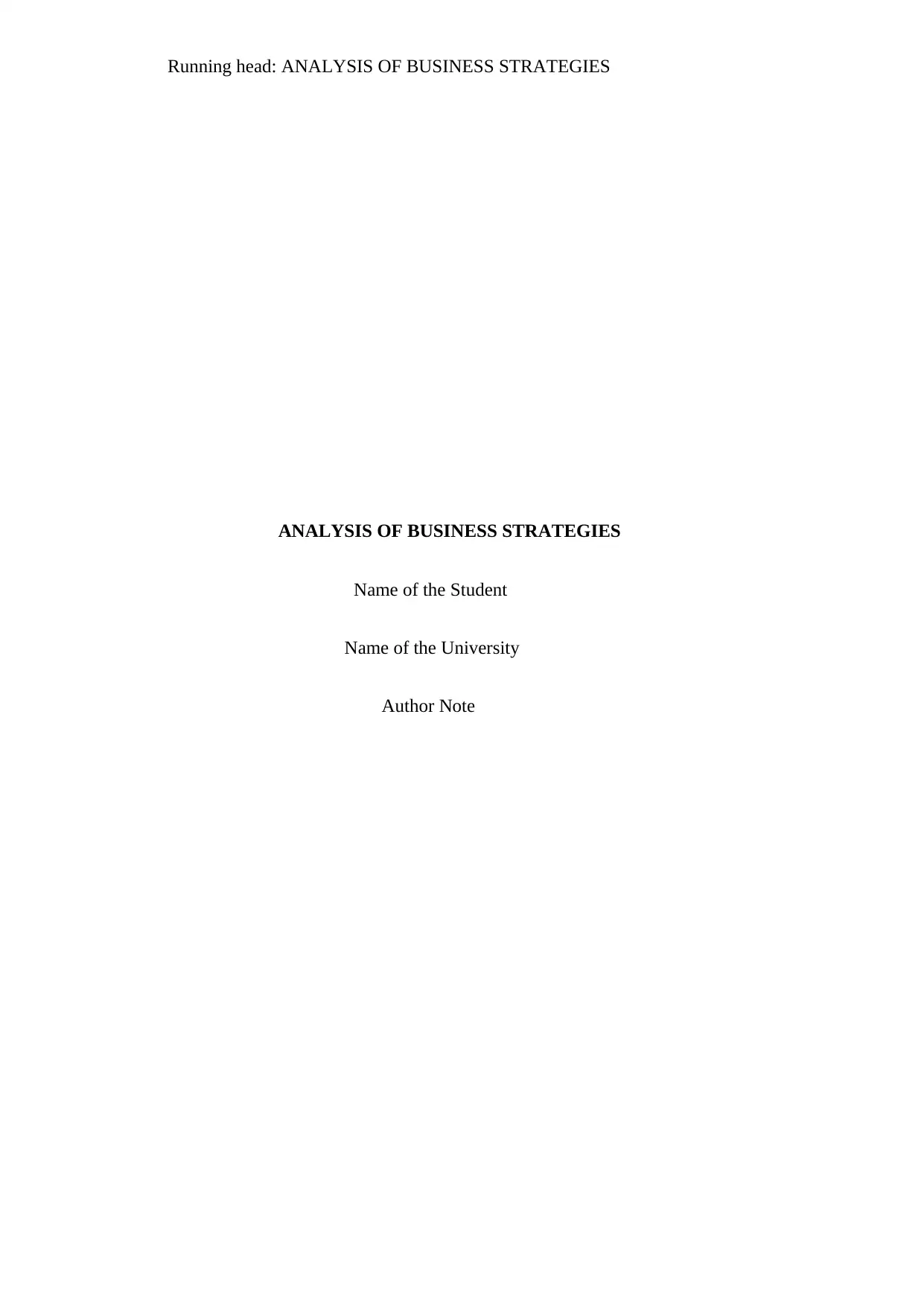
Running head: ANALYSIS OF BUSINESS STRATEGIES
ANALYSIS OF BUSINESS STRATEGIES
Name of the Student
Name of the University
Author Note
ANALYSIS OF BUSINESS STRATEGIES
Name of the Student
Name of the University
Author Note
Paraphrase This Document
Need a fresh take? Get an instant paraphrase of this document with our AI Paraphraser

1ANALYSIS OF BUSINESS STRATEGIES
Analysis of SWOT Framework
SWOT framework is used for analysing the internal environment of various
organizations in a detailed manner. The different aspects of the business that are a part of the
SWOT analysis process are strengths, the weaknesses, the opportunities and the threats. The
framework helps the strategists and the managers of different organizations to formulate
effective strategies.
Strengths – The various strengths that are related to the organization are, the
marketing mix elements, the USP of the products and services and the share the company
holds in the market. The demands that are related to the various services and products of the
organization and the management style that is followed in the companies are the major
strengths. The strengths enable the company to create a competitive position in the market
(Yu, 2017).
Weaknesses – The weaknesses are also a major part of the operations of
organizations in the market. The weak usage of the financial resources of an organization
form major weakness. The analysis of the reasons behind the company losing out to
competition in the market form a part in the weaknesses. The lack of loyal stakeholders in the
organization are also a weakness of these companies.
Opportunities – This aspect is related to the analysis of the possibilities of expansion
and innovation of the operations of various organizations. The new market areas where the
company plans for its operations and the expansion of its product and service offerings are
also major opportunities (Shabanova et al., 2015).
Threats – The high levels of competition in the market and the low prices of similar
services and products offered by the competitors are major threats to the operations of the
Analysis of SWOT Framework
SWOT framework is used for analysing the internal environment of various
organizations in a detailed manner. The different aspects of the business that are a part of the
SWOT analysis process are strengths, the weaknesses, the opportunities and the threats. The
framework helps the strategists and the managers of different organizations to formulate
effective strategies.
Strengths – The various strengths that are related to the organization are, the
marketing mix elements, the USP of the products and services and the share the company
holds in the market. The demands that are related to the various services and products of the
organization and the management style that is followed in the companies are the major
strengths. The strengths enable the company to create a competitive position in the market
(Yu, 2017).
Weaknesses – The weaknesses are also a major part of the operations of
organizations in the market. The weak usage of the financial resources of an organization
form major weakness. The analysis of the reasons behind the company losing out to
competition in the market form a part in the weaknesses. The lack of loyal stakeholders in the
organization are also a weakness of these companies.
Opportunities – This aspect is related to the analysis of the possibilities of expansion
and innovation of the operations of various organizations. The new market areas where the
company plans for its operations and the expansion of its product and service offerings are
also major opportunities (Shabanova et al., 2015).
Threats – The high levels of competition in the market and the low prices of similar
services and products offered by the competitors are major threats to the operations of the

2ANALYSIS OF BUSINESS STRATEGIES
organizations. The control that the organizations have over their revenues and credits are
analysed as a part of the weakness related factors. The old and outdated technologies used by
organizations are also a part of the weakness.
Example – The SWOT framework is used for analysing the retail industry and the
different aspects can be easily analysed with the help of this tool. The strengths of the
retailers can be analysed by discussing the financial backup that he has and the prices that he
offers to the customers. The unique product offerings of the retailers also form a part of the
strengths. The identification of weaknesses are also important in case of the retail industry as
it depicts the strength of the brand image of retailers. The opportunities of retailers are related
to expansion and identification of consumer needs. The threats that are posed towards the
profitability of the retailers helps them in formulation of strategies.
Analysis of PESTLE Framework
The PESTLE Framework is mainly used for the analysis of the external environment
where the organization has its operations. The most important factors that are analysed with
the help of this framework are, political, economic, legal, technological, social and
environmental. The PESTLE analysis framework provides a holistic view of the external
environment of an organization. The various aspects related to PESTLE analysis are
significant in understanding the industrial environment.
Political – These factors deal with the ways by which the government interferes in the
operations of the companies. The policies and the regulations that are formulated by the
government have immense effects on the organizational processes and profitability. The other
factors that are related to political aspects include the fiscal policies, the trade tariffs which
are decided by the government (Frynas & Mellahi, 2015).
organizations. The control that the organizations have over their revenues and credits are
analysed as a part of the weakness related factors. The old and outdated technologies used by
organizations are also a part of the weakness.
Example – The SWOT framework is used for analysing the retail industry and the
different aspects can be easily analysed with the help of this tool. The strengths of the
retailers can be analysed by discussing the financial backup that he has and the prices that he
offers to the customers. The unique product offerings of the retailers also form a part of the
strengths. The identification of weaknesses are also important in case of the retail industry as
it depicts the strength of the brand image of retailers. The opportunities of retailers are related
to expansion and identification of consumer needs. The threats that are posed towards the
profitability of the retailers helps them in formulation of strategies.
Analysis of PESTLE Framework
The PESTLE Framework is mainly used for the analysis of the external environment
where the organization has its operations. The most important factors that are analysed with
the help of this framework are, political, economic, legal, technological, social and
environmental. The PESTLE analysis framework provides a holistic view of the external
environment of an organization. The various aspects related to PESTLE analysis are
significant in understanding the industrial environment.
Political – These factors deal with the ways by which the government interferes in the
operations of the companies. The policies and the regulations that are formulated by the
government have immense effects on the organizational processes and profitability. The other
factors that are related to political aspects include the fiscal policies, the trade tariffs which
are decided by the government (Frynas & Mellahi, 2015).
⊘ This is a preview!⊘
Do you want full access?
Subscribe today to unlock all pages.

Trusted by 1+ million students worldwide
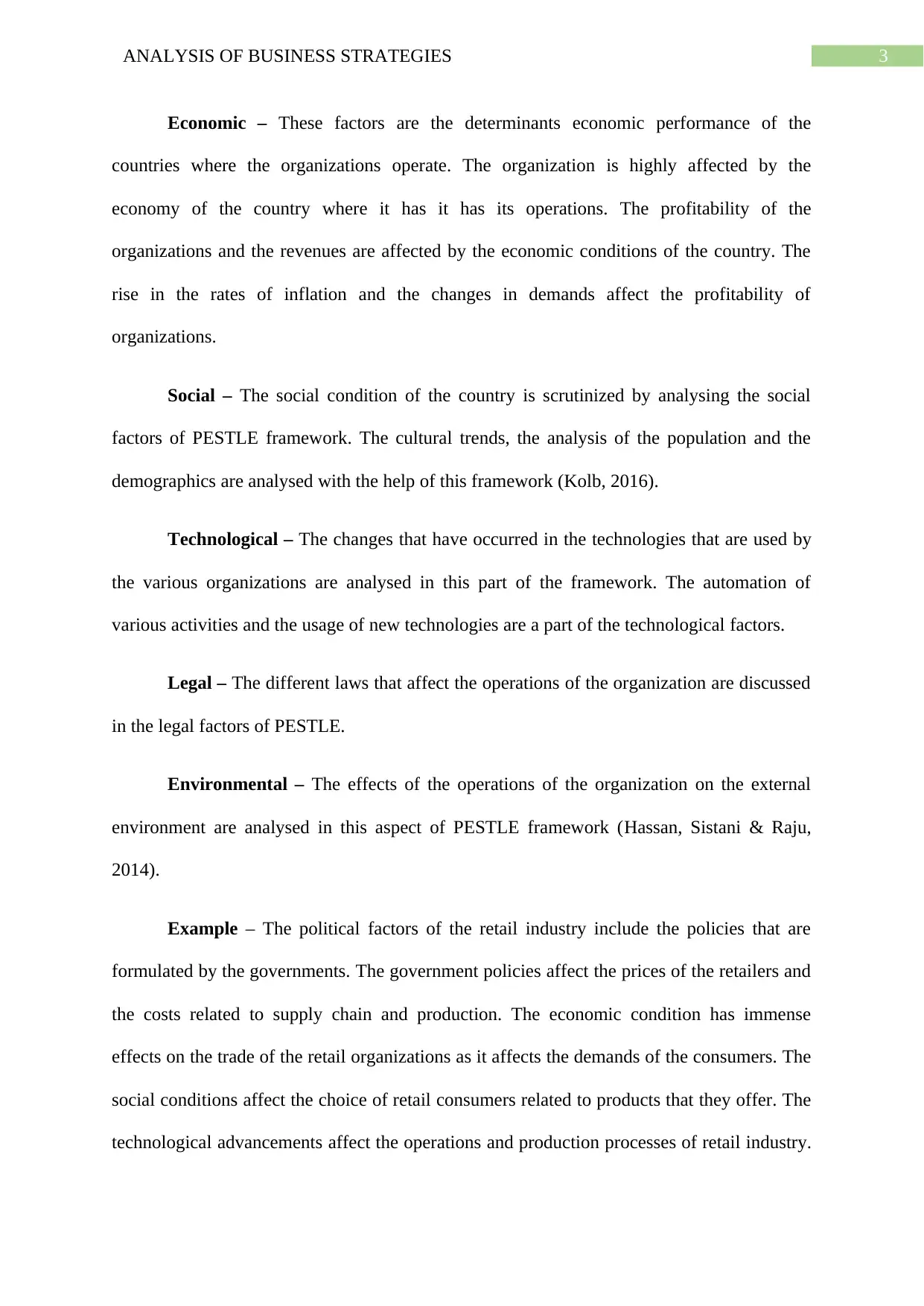
3ANALYSIS OF BUSINESS STRATEGIES
Economic – These factors are the determinants economic performance of the
countries where the organizations operate. The organization is highly affected by the
economy of the country where it has it has its operations. The profitability of the
organizations and the revenues are affected by the economic conditions of the country. The
rise in the rates of inflation and the changes in demands affect the profitability of
organizations.
Social – The social condition of the country is scrutinized by analysing the social
factors of PESTLE framework. The cultural trends, the analysis of the population and the
demographics are analysed with the help of this framework (Kolb, 2016).
Technological – The changes that have occurred in the technologies that are used by
the various organizations are analysed in this part of the framework. The automation of
various activities and the usage of new technologies are a part of the technological factors.
Legal – The different laws that affect the operations of the organization are discussed
in the legal factors of PESTLE.
Environmental – The effects of the operations of the organization on the external
environment are analysed in this aspect of PESTLE framework (Hassan, Sistani & Raju,
2014).
Example – The political factors of the retail industry include the policies that are
formulated by the governments. The government policies affect the prices of the retailers and
the costs related to supply chain and production. The economic condition has immense
effects on the trade of the retail organizations as it affects the demands of the consumers. The
social conditions affect the choice of retail consumers related to products that they offer. The
technological advancements affect the operations and production processes of retail industry.
Economic – These factors are the determinants economic performance of the
countries where the organizations operate. The organization is highly affected by the
economy of the country where it has it has its operations. The profitability of the
organizations and the revenues are affected by the economic conditions of the country. The
rise in the rates of inflation and the changes in demands affect the profitability of
organizations.
Social – The social condition of the country is scrutinized by analysing the social
factors of PESTLE framework. The cultural trends, the analysis of the population and the
demographics are analysed with the help of this framework (Kolb, 2016).
Technological – The changes that have occurred in the technologies that are used by
the various organizations are analysed in this part of the framework. The automation of
various activities and the usage of new technologies are a part of the technological factors.
Legal – The different laws that affect the operations of the organization are discussed
in the legal factors of PESTLE.
Environmental – The effects of the operations of the organization on the external
environment are analysed in this aspect of PESTLE framework (Hassan, Sistani & Raju,
2014).
Example – The political factors of the retail industry include the policies that are
formulated by the governments. The government policies affect the prices of the retailers and
the costs related to supply chain and production. The economic condition has immense
effects on the trade of the retail organizations as it affects the demands of the consumers. The
social conditions affect the choice of retail consumers related to products that they offer. The
technological advancements affect the operations and production processes of retail industry.
Paraphrase This Document
Need a fresh take? Get an instant paraphrase of this document with our AI Paraphraser
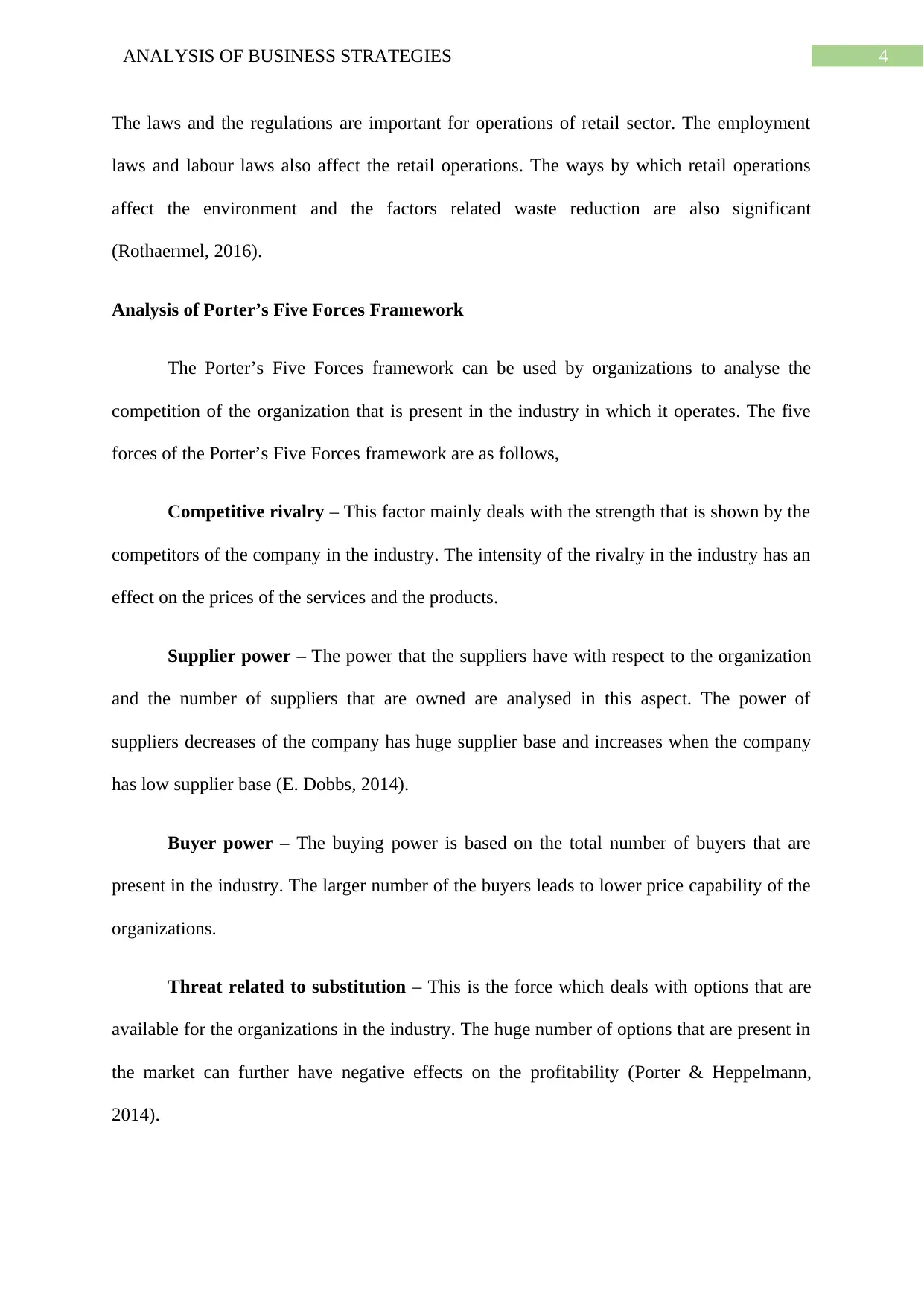
4ANALYSIS OF BUSINESS STRATEGIES
The laws and the regulations are important for operations of retail sector. The employment
laws and labour laws also affect the retail operations. The ways by which retail operations
affect the environment and the factors related waste reduction are also significant
(Rothaermel, 2016).
Analysis of Porter’s Five Forces Framework
The Porter’s Five Forces framework can be used by organizations to analyse the
competition of the organization that is present in the industry in which it operates. The five
forces of the Porter’s Five Forces framework are as follows,
Competitive rivalry – This factor mainly deals with the strength that is shown by the
competitors of the company in the industry. The intensity of the rivalry in the industry has an
effect on the prices of the services and the products.
Supplier power – The power that the suppliers have with respect to the organization
and the number of suppliers that are owned are analysed in this aspect. The power of
suppliers decreases of the company has huge supplier base and increases when the company
has low supplier base (E. Dobbs, 2014).
Buyer power – The buying power is based on the total number of buyers that are
present in the industry. The larger number of the buyers leads to lower price capability of the
organizations.
Threat related to substitution – This is the force which deals with options that are
available for the organizations in the industry. The huge number of options that are present in
the market can further have negative effects on the profitability (Porter & Heppelmann,
2014).
The laws and the regulations are important for operations of retail sector. The employment
laws and labour laws also affect the retail operations. The ways by which retail operations
affect the environment and the factors related waste reduction are also significant
(Rothaermel, 2016).
Analysis of Porter’s Five Forces Framework
The Porter’s Five Forces framework can be used by organizations to analyse the
competition of the organization that is present in the industry in which it operates. The five
forces of the Porter’s Five Forces framework are as follows,
Competitive rivalry – This factor mainly deals with the strength that is shown by the
competitors of the company in the industry. The intensity of the rivalry in the industry has an
effect on the prices of the services and the products.
Supplier power – The power that the suppliers have with respect to the organization
and the number of suppliers that are owned are analysed in this aspect. The power of
suppliers decreases of the company has huge supplier base and increases when the company
has low supplier base (E. Dobbs, 2014).
Buyer power – The buying power is based on the total number of buyers that are
present in the industry. The larger number of the buyers leads to lower price capability of the
organizations.
Threat related to substitution – This is the force which deals with options that are
available for the organizations in the industry. The huge number of options that are present in
the market can further have negative effects on the profitability (Porter & Heppelmann,
2014).

5ANALYSIS OF BUSINESS STRATEGIES
Threat related to new entrants in the market – This threat is related to the entry of
new organizations in the market. The high chances of organizations to enter the market
affects the existing companies in a negative manner. On the other hand, low chances of entry
of new organizations in the industry have low effects on the profitability of the existing
companies (Sheehan & Bruni-Bossio, 2015).
Example – The retail industry faces huge threats from new organizations that enter
the market. The huge options that are available for the retail products provide threats related
to substitutes to the organizations. The number of buyers that are present in retail industry are
quite high and the individual purchase is small. The power of the suppliers in the retail
industry is low as many suppliers are present for each company. The rivalry levels on the
other hand are high in the retail industry (Grant, 2016).
Threat related to new entrants in the market – This threat is related to the entry of
new organizations in the market. The high chances of organizations to enter the market
affects the existing companies in a negative manner. On the other hand, low chances of entry
of new organizations in the industry have low effects on the profitability of the existing
companies (Sheehan & Bruni-Bossio, 2015).
Example – The retail industry faces huge threats from new organizations that enter
the market. The huge options that are available for the retail products provide threats related
to substitutes to the organizations. The number of buyers that are present in retail industry are
quite high and the individual purchase is small. The power of the suppliers in the retail
industry is low as many suppliers are present for each company. The rivalry levels on the
other hand are high in the retail industry (Grant, 2016).
⊘ This is a preview!⊘
Do you want full access?
Subscribe today to unlock all pages.

Trusted by 1+ million students worldwide
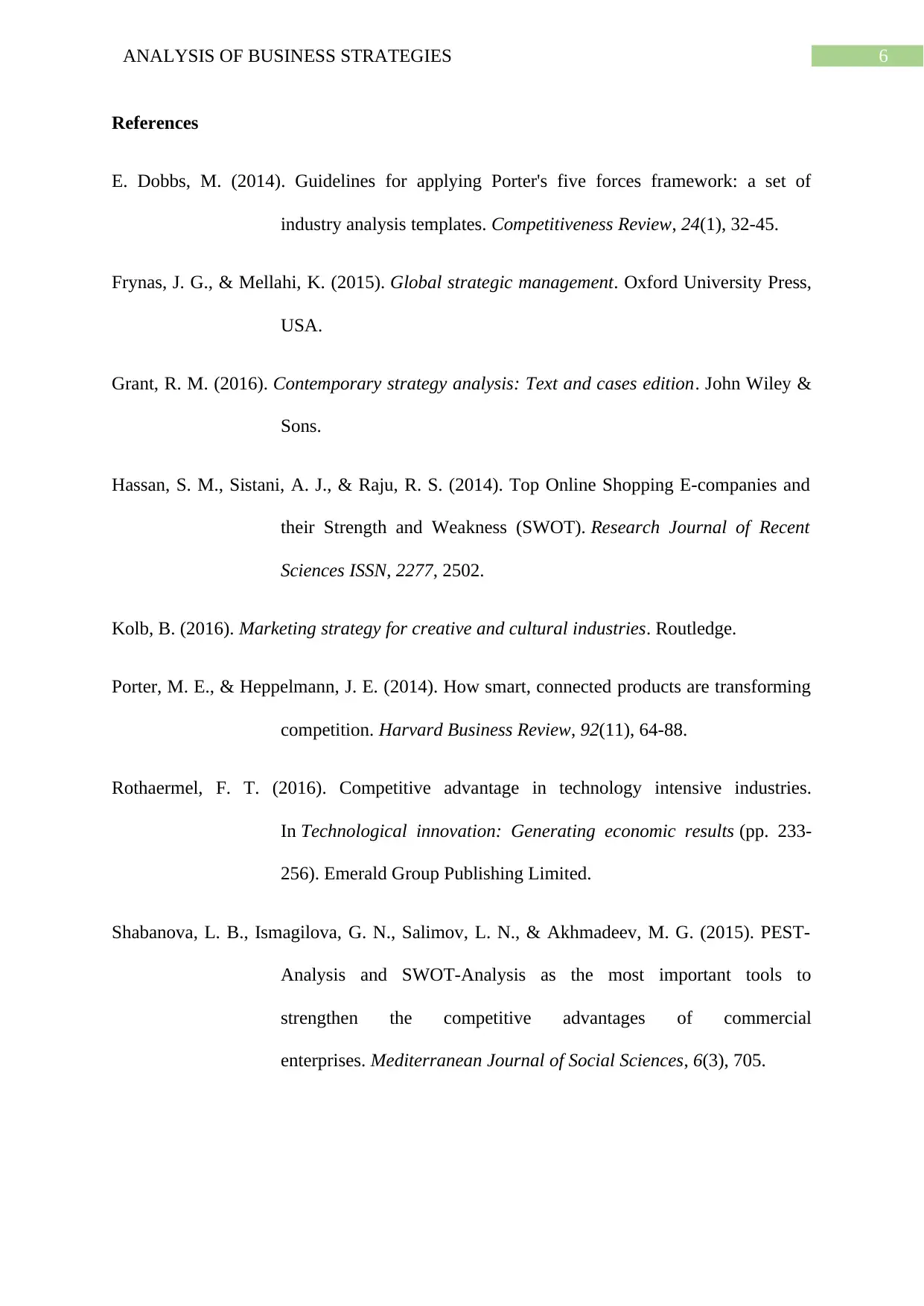
6ANALYSIS OF BUSINESS STRATEGIES
References
E. Dobbs, M. (2014). Guidelines for applying Porter's five forces framework: a set of
industry analysis templates. Competitiveness Review, 24(1), 32-45.
Frynas, J. G., & Mellahi, K. (2015). Global strategic management. Oxford University Press,
USA.
Grant, R. M. (2016). Contemporary strategy analysis: Text and cases edition. John Wiley &
Sons.
Hassan, S. M., Sistani, A. J., & Raju, R. S. (2014). Top Online Shopping E-companies and
their Strength and Weakness (SWOT). Research Journal of Recent
Sciences ISSN, 2277, 2502.
Kolb, B. (2016). Marketing strategy for creative and cultural industries. Routledge.
Porter, M. E., & Heppelmann, J. E. (2014). How smart, connected products are transforming
competition. Harvard Business Review, 92(11), 64-88.
Rothaermel, F. T. (2016). Competitive advantage in technology intensive industries.
In Technological innovation: Generating economic results (pp. 233-
256). Emerald Group Publishing Limited.
Shabanova, L. B., Ismagilova, G. N., Salimov, L. N., & Akhmadeev, M. G. (2015). PEST-
Analysis and SWOT-Analysis as the most important tools to
strengthen the competitive advantages of commercial
enterprises. Mediterranean Journal of Social Sciences, 6(3), 705.
References
E. Dobbs, M. (2014). Guidelines for applying Porter's five forces framework: a set of
industry analysis templates. Competitiveness Review, 24(1), 32-45.
Frynas, J. G., & Mellahi, K. (2015). Global strategic management. Oxford University Press,
USA.
Grant, R. M. (2016). Contemporary strategy analysis: Text and cases edition. John Wiley &
Sons.
Hassan, S. M., Sistani, A. J., & Raju, R. S. (2014). Top Online Shopping E-companies and
their Strength and Weakness (SWOT). Research Journal of Recent
Sciences ISSN, 2277, 2502.
Kolb, B. (2016). Marketing strategy for creative and cultural industries. Routledge.
Porter, M. E., & Heppelmann, J. E. (2014). How smart, connected products are transforming
competition. Harvard Business Review, 92(11), 64-88.
Rothaermel, F. T. (2016). Competitive advantage in technology intensive industries.
In Technological innovation: Generating economic results (pp. 233-
256). Emerald Group Publishing Limited.
Shabanova, L. B., Ismagilova, G. N., Salimov, L. N., & Akhmadeev, M. G. (2015). PEST-
Analysis and SWOT-Analysis as the most important tools to
strengthen the competitive advantages of commercial
enterprises. Mediterranean Journal of Social Sciences, 6(3), 705.
Paraphrase This Document
Need a fresh take? Get an instant paraphrase of this document with our AI Paraphraser
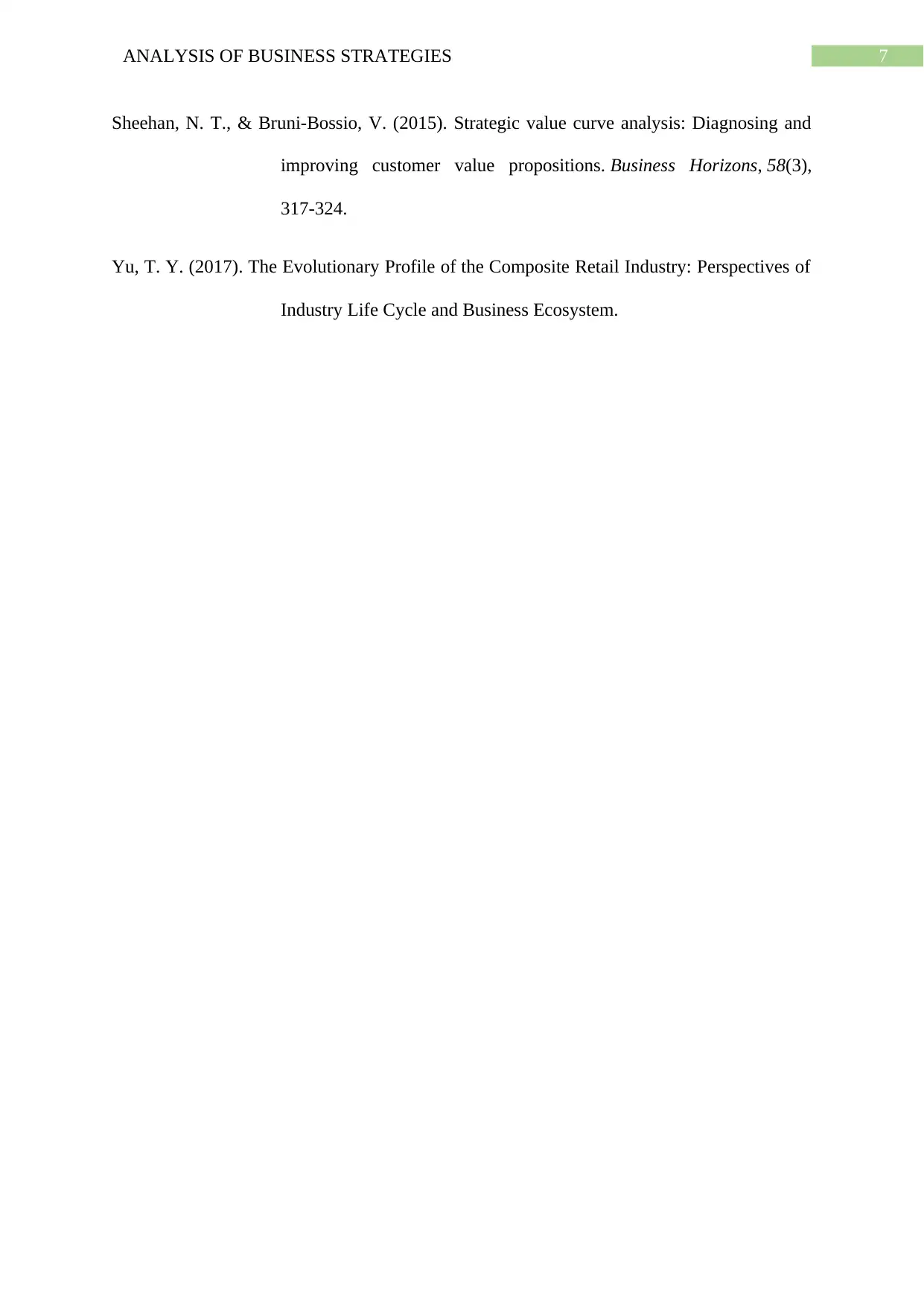
7ANALYSIS OF BUSINESS STRATEGIES
Sheehan, N. T., & Bruni-Bossio, V. (2015). Strategic value curve analysis: Diagnosing and
improving customer value propositions. Business Horizons, 58(3),
317-324.
Yu, T. Y. (2017). The Evolutionary Profile of the Composite Retail Industry: Perspectives of
Industry Life Cycle and Business Ecosystem.
Sheehan, N. T., & Bruni-Bossio, V. (2015). Strategic value curve analysis: Diagnosing and
improving customer value propositions. Business Horizons, 58(3),
317-324.
Yu, T. Y. (2017). The Evolutionary Profile of the Composite Retail Industry: Perspectives of
Industry Life Cycle and Business Ecosystem.
1 out of 8
Related Documents
Your All-in-One AI-Powered Toolkit for Academic Success.
+13062052269
info@desklib.com
Available 24*7 on WhatsApp / Email
![[object Object]](/_next/static/media/star-bottom.7253800d.svg)
Unlock your academic potential
Copyright © 2020–2025 A2Z Services. All Rights Reserved. Developed and managed by ZUCOL.





